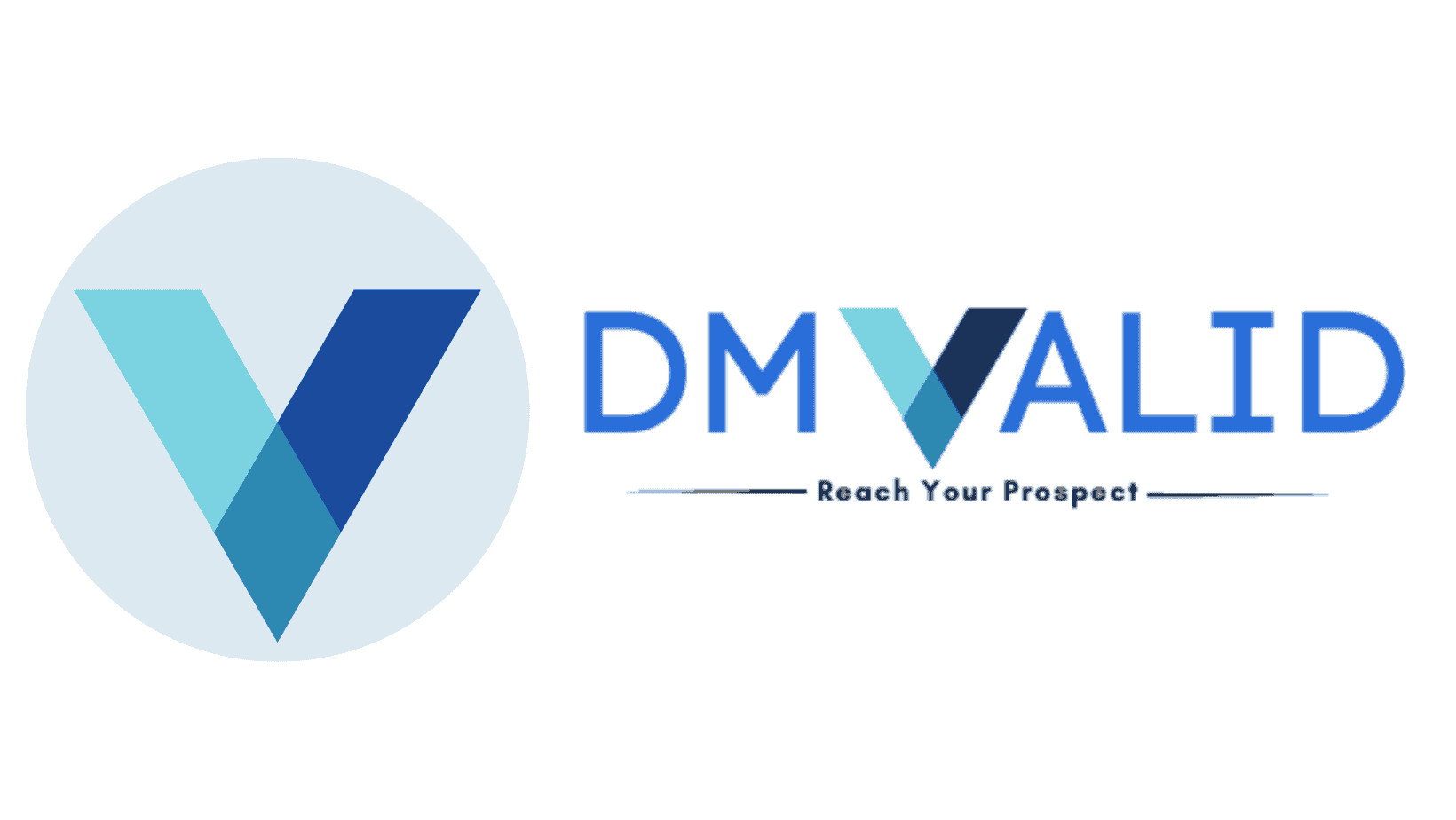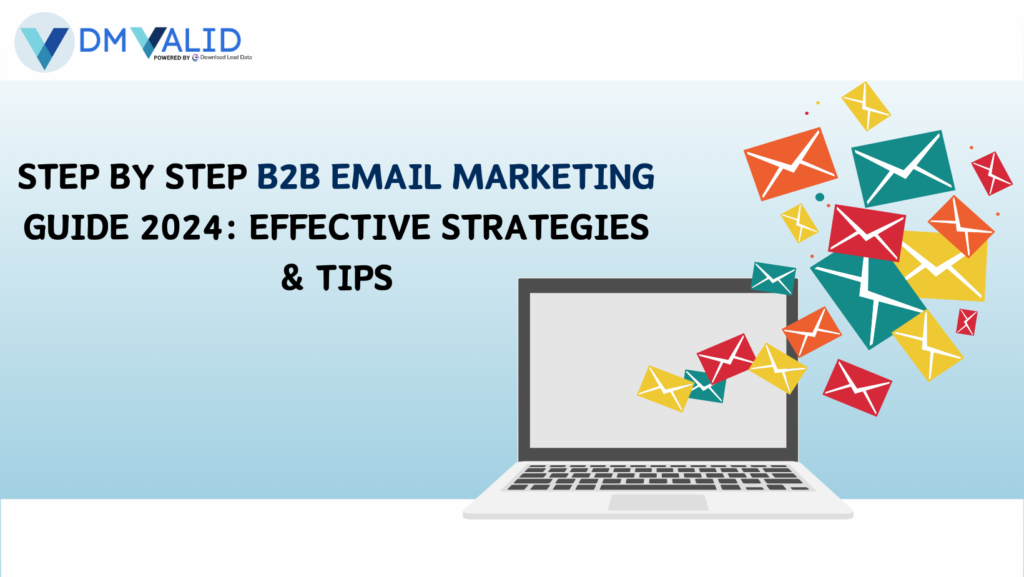Understanding B2B Email Marketing

- B2B email marketing is the practice of using email to promote products, services, or content from one business to another.
- The purpose of B2B email marketing includes building customer relationships, promoting products/services, increasing brand awareness, and driving sales.
- B2B email marketing is important because it provides a direct form of communication that establishes a stable connection to the audience.
- The goal of B2B email marketing is to deliver valuable and relevant information, which helps influence purchasing decisions.
- B2B email marketing differs from B2C email marketing primarily due to its different target audiences and goals, necessitating a tailored strategy.
- Types of campaigns in B2B email marketing include single announcement emails, ongoing newsletters, and product update communications.
The Role of Email Marketing in B2B
- B2B email marketing is essential for capturing leads and facilitating the sales process over a more extended period.
- B2B email marketing builds professional relationships, generates leads, and drives sales.
- In B2B email marketing, the focus is on nurturing relationships through informative content rather than just immediate sales.
- B2B email marketing focuses on delivering valuable information to build professional relationships.
- Marketing creates campaigns to nurture leads, while sales builds relationships to convert these leads.
- Effective email marketing strategies can nurture leads and increase revenue.
- B2B email marketing helps capture attention, deliver value, and guide prospects towards meaningful action.
- B2B email marketing significantly powers up the sales cycle through continuous engagement.
Key Benefits of B2B Email Marketing
- Email marketing ROI increased from 47.75 USD in 2020 to 51.52 USD in 2021.
- Email marketing is considered a top free organic distribution channel by 87% of B2B marketers, allowing for direct engagement with potential clients.
- Consistent and relevant content in B2B email marketing increases engagement rates and improves data collection.
- Personalized content is essential for B2B email marketing, leading to higher open rates and improved customer engagement.
- Emails that are personalized can increase open rates by 111% and revenue by 171%.
- 80% of marketers use personalization in emails, indicating the widespread acknowledgment of its importance.
- B2B email marketing effectively combines high ROI, direct communication, and personalized content to drive business success.
Setting Up Your B2B Email Marketing Strategy
- Email marketing remains a crucial tool for both B2B and B2C companies due to its cost-effectiveness and global reach.
- B2B email marketing requires a well-structured strategy tailored to the needs of businesses rather than individual customers.
- Effective B2B email campaigns benefit from focusing on long-term relationships and delivering valuable information.
- A plan is necessary to create an effective email marketing strategy.
- You need an effective B2B email marketing strategy to convert leads into customers.
- The effective email strategy can be broken down into a few key steps.
- For creating B2B emails, it is important to have focused messages, personalization, and professionalism.
- B2B emails should be tailored to the target audience through personalization and effective CTAs.
- GDPR compliance gives customers the right to choose whether to receive emails.
- It’s a misconception that executing B2B email marketing is easy; it requires careful planning.
- Automation tools like HubSpot can enhance efficiency in B2B email marketing.
Defining Your Goals and KPIs
- Setting clear goals, such as increasing demo bookings or generating MQL for sales teams, is essential for B2B email marketing success.
- Some example goals for B2B email marketing include increasing overall signups and reaching new personas.
- Using industry benchmarks is crucial when setting achievable goals for your email marketing campaigns.
- Common key performance indicators (KPIs) for B2B email marketing include open rates, click-through rates, and MQL to SQL conversion ratios.
Building Your Email List
- Building an email list is crucial for successful B2B email marketing, as it allows for targeted communication with prospects and leads.
- Utilizing lead magnets effectively can significantly enhance email signup rates by offering something of value in exchange for contact information.
- A well-designed opt-in form is critical for capturing potential subscribers’ information and should be branded, stand out, and enticing to readers.
- The combination of effective lead magnets and well-designed opt-in forms forms the backbone of a strong email list, which can take time to build but is essential for ongoing marketing success.
Segmenting Your Audience
- Segmenting the audience based on firmographics and decision-making roles can lead to more effective B2B email marketing.
- The purpose of email segmentation in B2B email marketing is to group subscribers based on characteristics like buyer personas for tailored content.
- The most important segment characteristics need to be reviewed before dividing your audience for segmentation.
- Email lists should be segmented based on contact data and behavior to enhance targeting accuracy.
- Creating separate lead magnets and opt-in forms for different buyer’s journey stages is an essential step in segmenting email lists.
- Segmentation by demographics is vital for crafting tailored email messages that resonate with the audience.
- A crucial aspect of crafting emails for different recipients is segmenting the audience by demographics and communication preferences.
- Understanding customer pain points and characteristics is essential for effective segmentation in B2B marketing.
- Audience segmentation increases the relevancy of email messages, ultimately improving engagement.
- Segmentation improves the effectiveness of marketing and sales messages, leading to greater campaign success.
Crafting Compelling B2B Email Campaigns
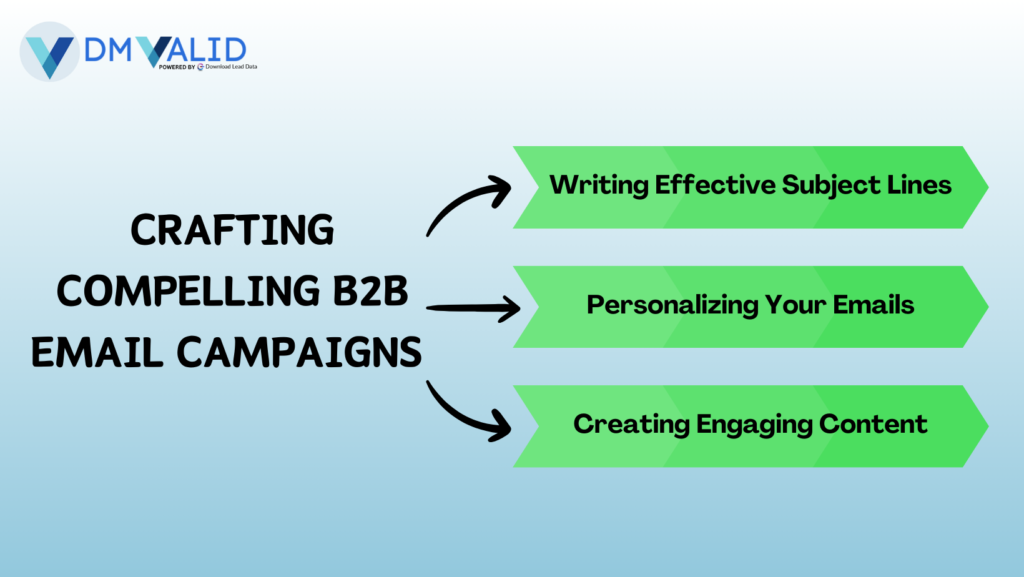
- The ADHD method is a step-by-step guide for creating effective B2B emails.
- It’s essential to treat the reader like you’re writing to a friend for engaging communication.
- Follow a specific set of steps tailored for B2B leads to create an effective email marketing campaign.
- Key components of an effective B2B email include addressing pain points, using bullet points for legibility, and including a clear call to action.
- Using AI in emails allows for advanced personalization and helps in crafting emails that resonate with the audience.
- Choose effective, high-quality templates from reputable ESPs to enhance the design and engagement of your emails.
- Consider the types of campaigns and their relevance to the audience when planning email content.
- HubSpot’s tools like personalization and A/B testing can significantly enhance your email marketing efforts.
- Promote upcoming events and allow subscribers to register through email as a method to engage and convert.
- Using email marketing templates saves time and helps with design, coding, and user experience.
- Utilizing AI can assist in writing emails, allowing marketers to save time and enhance creativity.
Writing Effective Subject Lines
- In B2B email marketing, subject lines are crucial as they help capture attention in a crowded digital landscape.
- Summarizing the email’s content while addressing the recipient’s pain points in the subject line enhances relevance and engagement.
- Using clear, actionable, and enticing language is vital for creating compelling subject lines.
- Creating a sense of urgency in subject lines encourages recipients to open emails quickly.
- B2B marketers can utilize subject line testers like Refine to evaluate and test the effectiveness of their subject lines.
- Avoiding misleading subject lines is essential, as they can damage trust and lead to decreased open rates.
- The preview text in emails acts as a valuable tool to grab attention and encourage opens, complementing the subject line.
Personalizing Your Emails
- Personalized emails can lead to a substantial increase in engagement, boosting open rates and overall effectiveness.
- Customizing emails for targets’ actual needs results in more effective emails and fewer unsubscribes or spam reports.
- Key factors for personalizing emails in B2B marketing include location, industry, employee size, and engagement with content.
- Emails can be personalized for B2B recipients by using import fields for recipient names, company names, and specific information.
- Advanced email personalization requires using the full capabilities of a marketing automation system.
- Marketing automation can improve email personalization by tracking the effectiveness of subject lines and opening techniques for different segments.
- Using plain-text emails can increase the feeling of personalized messaging.
Creating Engaging Content
- B2B emails should focus on addressing the customer’s pain points, creating connections, and building engagement.
- Effective educational content includes industry benchmarks and how-to guides, tailored to specific buyer personas.
- Use smart formatting and maintain a sparse design to ensure emails are engaging and easy to skim.
- B2B calls-to-action should be value-driven, straightforward, and easy to find to boost conversions.
- Use Free AI Email Writer tool helps you craft personalized, high-converting email content effortlessly. Leverage AI to create engaging emails that save time and boost your email marketing success.
Automating Your B2B Email Campaigns
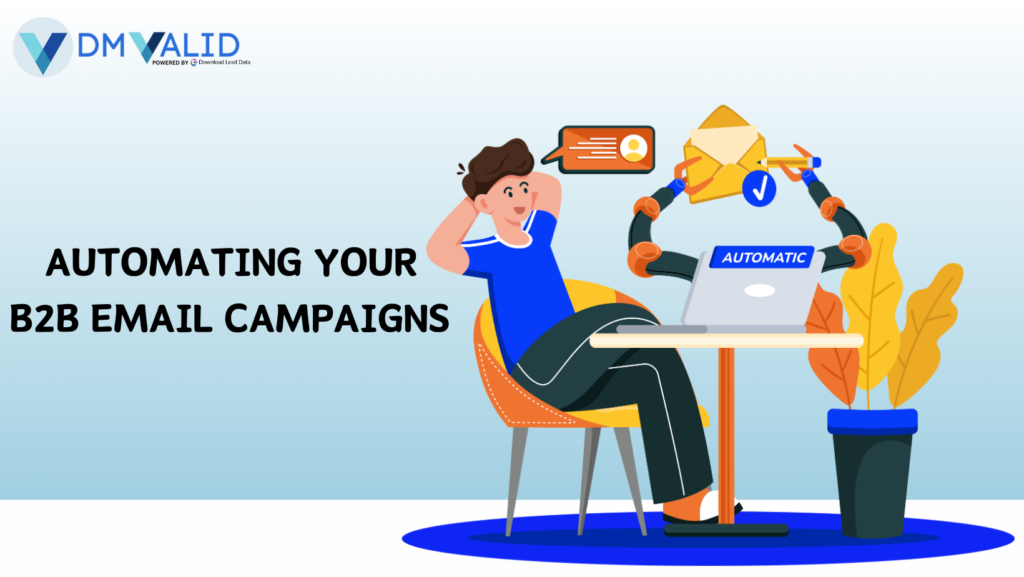
Email automation is essential for enhancing communication and delivering personalized content while nurturing leads efficiently.
Choosing the Right Email Marketing Platform
- Consider criteria such as comprehensive digital marketing tools, robust email builders, and lead generation features when selecting an email marketing platform.
- An effective email marketing platform should facilitate tracking of leads and performance, and provide automation processes.
- Using an email marketing tool like HubSpot can help create, personalize, and optimize your email marketing efforts.
- Popular platforms such as Mailchimp and Sender simplify the campaign management process, catering to various marketing needs.
- HubSpot offers a free email marketing service which could be beneficial for startups and small businesses.
- Always include a fallback version of HTML emails to enhance customer experience if the HTML fails to render properly.
Setting Up Automated Workflows
- Automated workflows streamline the email marketing process by allowing marketers to send specific messages based on user interactions.
- Triggered emails based on user actions can increase engagement and improve the customer journey.
- An example of an action that can trigger an email in automation is clicking a link to an ebook landing page.
- Implementing automated workflows can lead to higher engagement rates and a more personalized experience for the customer.
Best Practices for B2B Email Marketing in 2024
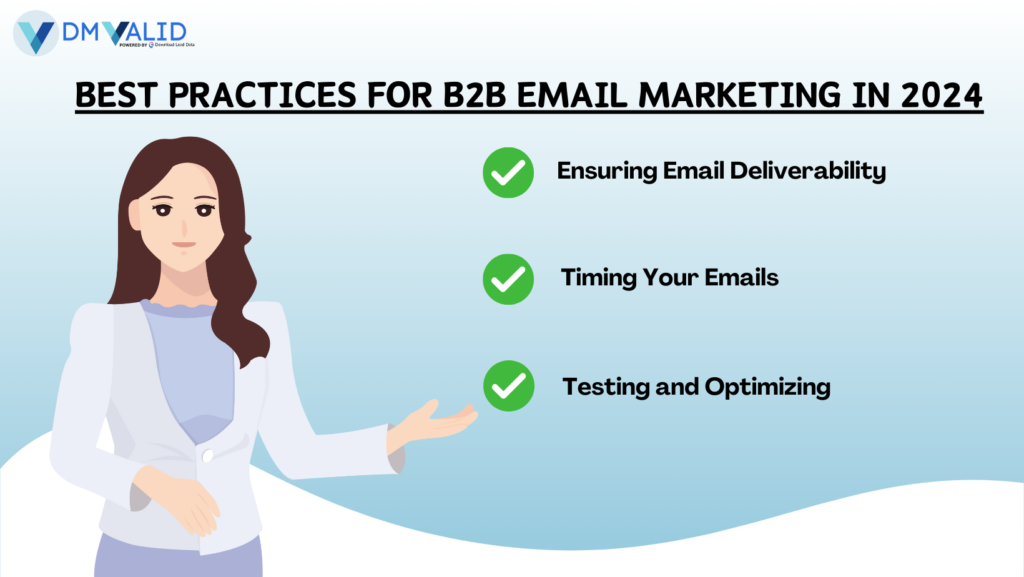
- Email marketing is viewed as a top organic distribution channel by 87% of B2B marketers.
- B2B email marketing offers a high return on investment, with ROI increasing significantly year over year.
- B2B email marketing significantly influences multichannel strategies, with 50% of marketers acknowledging its impact.
- Understanding campaign performance is crucial for optimizing future email strategies.
- Announcing new products through emails is crucial for keeping customers informed and engaged with your offerings.
Ensuring Email Deliverability
- Ensuring email deliverability is essential to make sure that emails land in the inbox and not the spam folder.
- Avoiding spam filters is critical because it directly affects whether emails reach the intended audience.
- Using a reliable email service provider is crucial for maintaining high deliverability rates.
- A good email service provider can help with compliance and improve sending reputation.
- To avoid being categorized as spam, email content should avoid trigger words and excessive punctuation.
- Avoiding all caps and multiple exclamation points in email copy can help prevent triggering spam filters.
- Adhering to regulations and ensuring email quality is essential to help avoid being marked as spam.
Timing Your Emails
- Timing your emails effectively is crucial for enhancing engagement and boosting open rates.
- The recommended day and time to send emails for optimal response rates is Tuesday at 11 AM ET.
- When determining the timing of B2B email sends, it’s important to consider various surveys that indicate optimal sending times.
- The best times to send B2B emails can vary based on factors such as industry, target audience, email types, and lead segmentation.
Testing and Optimizing
- A/B testing is essential in email marketing to identify which elements resonate best with audiences.
- The benefit of A/B testing in email marketing is to determine which email version yields better engagement.
- Experiment with variables in your emails to improve results if you’re not getting desired metrics.
- Analyzing data from email campaigns will help improve your B2B email strategy.
- Testing email elements such as subject lines and content is crucial for optimizing email campaigns.
- A/B testing should be run with intention; avoid unscientific methods to ensure valid results.
- It is recommended to use A/B testing tools provided by email marketing software to conduct tests effectively.
- Metrics such as open rate, click-through rate, and unsubscribe rate are critical for measuring A/B testing outcomes.
Analyzing and Measuring Your Email Campaign Performance
- A good email marketing platform should offer robust analytics to help you measure campaign success.
- Regular analysis of key metrics is vital for refining and optimizing email marketing strategies over time.
- After launching your first few email campaigns, it is essential to analyze their performance to identify areas for improvement.
- Continuous analysis of your email campaigns not only helps in achieving immediate objectives but also in strategizing future campaigns effectively.
Key Metrics to Track
- Establishing metrics is crucial for tracking the success of B2B email marketing efforts, including open rates and conversion ratios.
- Key metrics to evaluate the effectiveness of email marketing include open rates, click-through rates, and conversion rates.
- Personalization, such as using the subscriber’s name, can significantly enhance email open rates and conversions.
- Metrics can be influenced by factors including industry, customer journey stage, content type, and offering.
- Failing to track and analyze email performance can lead to missed opportunities for improvement.
Using Analytics Tools
- Analyzing email campaign data is crucial for improving engagement and understanding audience behavior.
- To track email performance effectively, use website analytics, email analytics, and CRM analytics.
- HubSpot’s Marketing Analytics software is a powerful tool that helps in understanding the defined audience better.
- Utilizing these analytics tools helps refine email marketing strategies and improve future campaigns.
Reporting and Improving
- The purpose of an email marketing report is to organize results and make inferences from KPIs.
- After completing A/B testing, it is important to monitor campaign performance metrics to gauge effectiveness.
- Measuring unsubscribe rates helps identify issues that could affect ongoing email list health.
- Utilizing insights gained from reports can lead to targeted improvements in campaign strategies.
- Regularly refining email content based on previous campaign data is essential for sustained engagement.
Examples of Successful B2B Email Campaigns

- Successful B2B email campaigns leverage specific strategies and formats that resonate with their audience.
- Including social proof in emails, such as customer testimonials and case studies, can enhance the credibility of your message.
- Some of the most effective B2B email campaigns are recognized for their strategic utilization of personalization, automation, and relevant content.
- Lessons learned from successful B2B campaigns can provide insights into effective email marketing practices that drive engagement and conversions.
Welcome Email Example
- A B2B welcome email is crucial for setting the tone of the relationship and retaining subscribers.
- A successful welcome email should highlight the achievements possible with products or services offered.
- Educating subscribers first before pushing for a conversion is a recommended strategy in B2B welcome emails.
- An effective welcome email can significantly improve engagement and conversion rates for subsequent interactions.
Re-Engagement Campaign Example
- Re-engagement campaigns are designed to rekindle interest among inactive subscribers, ensuring continued engagement with the audience.
- Re-engagement emails aim to revive interest from inactive subscribers and often include surveys to collect their opinions.
- A successful re-engagement campaign may involve offering exclusive content or incentives to encourage subscribers to reconnect.
- By effectively implementing a re-engagement campaign, businesses can improve their email marketing efforts and enhance subscriber loyalty.
Product Launch Email Example
- Product launch emails are vital for informing customers about new offerings and driving interest.
- The main objectives of a product launch email campaign include generating excitement, increasing product awareness, and driving conversions.
- An effective product launch email should clearly communicate the product’s benefits, include engaging visuals, and have a strong call to action.
- Creating announcement emails for big news is an effective practice for B2B email marketing to engage customers.
Common Pitfalls to Avoid in B2B Email Marketing
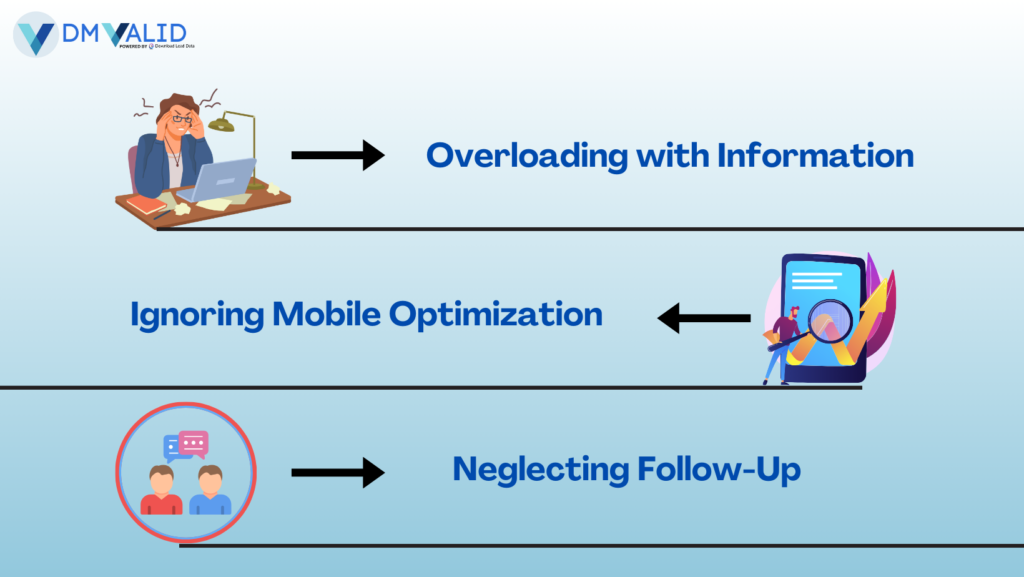
- Informing your audience about the email contact schedule helps avoid high unsubscribe rates and reduces the chance of emails ending up in spam.
- A common mistake in B2B email communication is using dry, corporate language that fails to engage the audience.
- Neglecting audience engagement can lead to decreased effectiveness of email campaigns and higher unsubscribe rates.
- To avoid pitfalls, focus on clear, relatable communication and maintain transparency regarding email schedules.
Overloading with Information
Use a bulleted list for actionable information in emails to enhance clarity and conciseness.
Ignoring Mobile Optimization
- Over 60% of emails are accessed on mobile devices, making mobile optimization essential for effective communication.
- Over half of all emails are accessed on mobile devices, indicating the need for mobile-friendly designs.
- Optimizing emails for mobile is essential as a significant portion of users access emails via smartphones.
- Emails that aren’t mobile-friendly can lead to a significant drop in engagement from recipients.
Neglecting Follow-Up
- Consistent follow-up emails are essential for nurturing leads and moving them along the sales funnel.
- Effective follow-up helps build trust and credibility with potential customers, making it critical for lead management.
- Research shows that timely follow-ups can increase conversion rates significantly, demonstrating their necessity.
- One effective strategy for follow-up emails is to automate them based on specific triggers or actions taken by leads.
- Personalizing follow-up emails based on previous interactions can enhance engagement and response rates.
- Using a sequence of follow-up emails can help keep your brand top-of-mind and encourage further engagement.
- Overall, consistent follow-up through emails is vital to maximizing the effectiveness of B2B email marketing efforts.
Content Writer at DM Valid
Asifa Khanum is a Content Specialist at DM Valid I fulfilled roles in marketing that shaped her interest in finding innovative solutions to modern-day problems.
